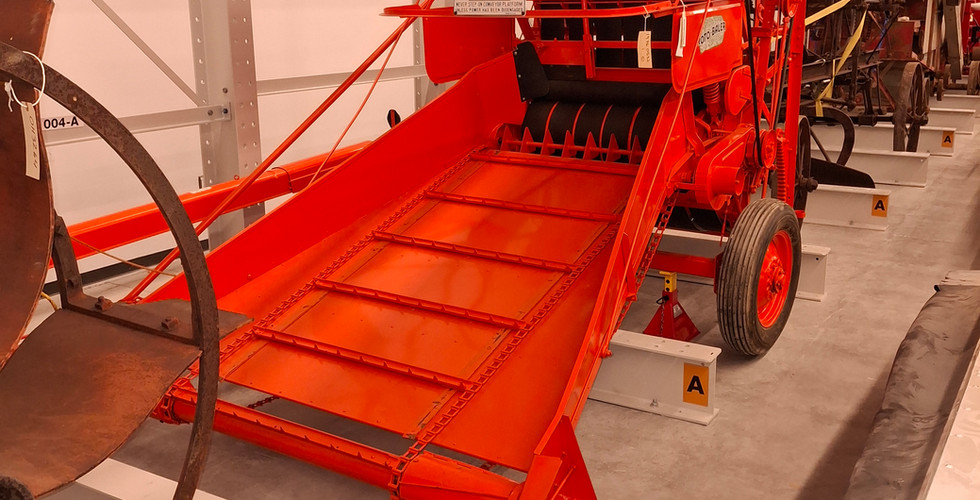One Hundred Thirty Nine Harvests: Haying at the Central Experimental Farm and the Canada Agriculture and Food Museum
- Year On the Field Project
- Aug 29
- 7 min read
As a working farm and historic site in the heart of Canada’s Capital, the decision to highlight hay by the A Year On The Field project was very fitting and exciting for us. Indeed, hay has long played an important role at the Canada Agriculture and Food Museum and the Central Experimental Farm National Historic Site in Ottawa, Ontario. Hay was one of the first crops seeded at the Farm, as it is known to Ottawans, when it was established in 1886[1]. It was necessary to feed the farm’s livestock, especially its horses and dairy cattle. It was also a significant subject of research and experimentation[2]. Hay is still an important crop as research into forage plants is ongoing. Today, hay is grown by the Canada Agriculture and Food Museum to feed its Dairy Showcase Herd and other livestock, including beef cattle, horses, sheep and goats.

The 427-hectare Central Experimental Farm (CEF) was established by an Act of Parliament in 1886 to test and develop different breeds of livestock and varieties of cereals, legumes, grasses, fruits, vegetables and trees suited to the various environmental conditions found in Canada’s agricultural regions[3]. The CEF eventually became the heart of a network of research farms, stations and field sites found throughout the country. The goal of the system was, and still is, to support the establishment and advancement of agriculture by providing farmers with information, crop varieties, and livestock breeds adapted to the circumstances of their farms.

Forage crops have been an important area of research since the CEF’s inception. Upon being appointed director of the Experimental Farms in October 1886, Dr. William Saunders realized that very few species of grasses and legumes were cultivated in Canada. Accordingly, research into cold-tolerant, drought-resistant and high yielding forage was needed not only to support existing agriculture in Eastern Canada, but also to help expand farming and ranching in the North-West Territories, later to become the provinces of Saskatchewan and Alberta[4]. Saunders obtained seeds from countries with similar climatic conditions to Canada and started testing samples in Ottawa and other research stations throughout the country. By 1900, useful species had been identified and research to adapt and improve plants was under way.

While research into hay plants was initially entrusted to the Division of Entomology and Botany, the need for better hay and ensilage crops was significant enough that an independent Division of Forage Plants was established in 1912. It was tasked with testing varieties of grasses, legumes, corn and field roots to select and isolate the breeding material needed to originate new and improved plants. These were to be specially adapted to the varied environmental conditions found in Canada.[5] Legumes, including alfalfa, clover, sainfoin, birdsfoot trefoil, and cicer milkvetch, were studied, tested and bred. Varieties of grasses like timothy, bromegrass, orchardgrass, bluegrass, fescue and wheatgrass followed suit. Combination of legumes and grasses were also evaluated for use as forage crops and pasture. Feeding trials also took place and led to the development of recommendations based on a farmer’s specific objectives (animal maintenance, fattening, or reproduction). Work progressed and by the 1920s, scientists had selected and distributed improved varieties of forage plants[6]. Field roots such as turnips, mangels, carrots, and sugarbeets, widely used as fodder at the beginning of the 20th century, were also studied. However, with research at the experimental farms having helped develop better quality and in less labor-intensive grass and legume varieties, field roots would gradually be abandoned in favor of better hay crops.[7]
Historical images slide show:
Historical Slide Show Fig. 4–11; Fig. 4 Horse-drawn sickle mower mowing a clover field at the Central Experimental Farm during the 1930s; Fig. 5 Tedding hay with a horse-drawn tedder, undated; Fig. 6 Loose dry clover harvested from Rotation X1 experiment at the Central Expearimental Farm, 1926; Fig. 7 Mowing hay with a tractor rear-mounted mower, 1948; Fig. 8 Testing a hay crusher at the Central Experimental Farm during the 1940s; Fig. 9 Baling hay at the Central Experimental Farm in 1955; Fig. 10 Testing a rotary baler. The image shows a rear view of the baler, with the bale about to be ejected, undated; Fig. 11 Shedder type forage harvester eases labour load harvesting cured hay. Ottawa, Ontario, 1950s.
CEF researchers also conducted field and soil husbandry trials to determine the best hay crop practices. Tillage and seeding, fertilization, and harvesting technologies and methods were tested. The inclusion of hay into crop rotations was also studied to better understand and ensure long-term soil health. Scientists developed and published recommendations that helped farmers maximize quality and yields of their hay crop. Finally, various methods of storing hay, from stacking loose hay, to baling or chopping it into silage were examined to maximize nutrient retention and feeding efficiency. In 1924, the Farm launched a drafting service to create standard plans of farm buildings, including barns and storage sheds, which were published and made available to farmers[8]. Research into hay is still ongoing in Canada’s experimental farm system, with scientist and farmers now focused on developing new varieties and management practices better adapted to changing environmental conditions. Trials are also underway to help determine how forage crops can help mitigate the current climate crisis.[9]

On the historical and museological side of things, hay and its associated material culture has been an important area of focus for the Canada Agriculture and Food Museum. When the current iteration of the museum opened in 1983, it featured the permanent exhibition Haying in Canada—from Scythe to Forage Harvester, which detailed the evolution and mechanization of haying machinery. While that exhibition has long since been replaced, hay is continually interpreted throughout the site, especially in some of the museum’s barns, to inform visitors less familiar with agriculture about the production, storage, and distribution of farm animal feed.
The museum’s collections, accessible through their online portals, tell the story of haymaking technology and practices in Canada. The museum’s artefact collection features hundreds of artefacts linked to hay and haymaking. From scythes and hay forks to mowers, tedders, rakes, balers, and forage harvesters, the collection speaks to the mechanization of haying as well as to the research and development of new plant varieties in Canada. From treaties on the best haymaking practices, to trade literature highlighting the latest haying technology, and incredible photography collections, the museum’s Library and Archives features a treasure trove of documents detailing hay’s incredible journey in Canada.
Ingenium artefacts slide show:
Artefacts Slide Show Fig. 13–24; Fig. 13 Welland-Vale, Scythe, circa 1950; Fig. 14 Unknown Manufacturer, Fork, hay, Unknown Date; Fig. 15 Brantford (Harris), Mower, circa 1880–1890; Fig. 16 Chalifoux, O. & Fils, Baler, hay, circa 1881.
Ingenium trade literature slide show:
Trade literature Slide Show Fig. 25–30
The museum’s Farm Operations’ team continues the haymaking tradition established at the Central Experimental Farm National Historic Site since 1886. Every year, museum staff sow, maintain, harvest, and feed over 350 tons of dry and silage hay, mostly in the form of small and large square bales, much to the enjoyment of the farm’s livestock and to visitors lucky enough to visit the museum on a harvest day!
Fig. 31&32 The museum’s Farm Operations’ team continues the haymaking tradition established at the Central Experimental Farm National Historic Site since 1886. Every year, museum staff sow, maintain, harvest, and feed over 350 tons of dry and silage hay, mostly in the form of small and large square bales, much to the enjoyment of the farm’s livestock and to visitors lucky enough to visit the museum on a harvest day! Canada Agriculture And Food Museum Farm Operations team raking and baling hay at the Central Experimental Farm on July 23rd, 2025.
If you are interested in learning more about the history of hay at the Central Experimental Farm and the Canada Agriculture and Food Museum, or if you want to learn more about our collections, feel free to visit our websites:
- Canada Agriculture and Food Museum: https://ingenium.ca/agriculture/en/
- Ingenium Collection Online: https://collection.ingenium.ca/en/
- Ingenium Library and Archives: https://ingenium.ca/en/collections-research/collection/library-and-archives/
[1] W. M. Saunders, Results of Experiments with Early, Medium and Late Sowings of Grain, Central Experimental Farm Bulletin No. 21, Ottawa, Department of Agriculture, March 1865. p. 3
[2] T. H. Anstey, One Hundred Harvests, Ottawa, Research Branch, Agriculture Canada, 1986. p. 234
[3] Act respecting Experimental Farm Stations. A.D. 1886 in The Rived Statutes of Canada, volume I, Ottawa, Brown Chamberlain, 1887. p. 889-892
[4] T. H. Anstey, One Hundred Harvests, Ottawa, Research Branch, Agriculture Canada, 1986. p. 234
[5] Experimental Farms Reports for the year ending March 31, 1913, Ottawa, C.H. Parmelee, 1914. p. 53.
[6] T. H. Anstey, One Hundred Harvests, Ottawa, Research Branch, Agriculture Canada, 1986. p. 234-235
[7] T. H. Anstey, One Hundred Harvests, Ottawa, Research Branch, Agriculture Canada, 1986. p. 242
[8] T. H. Anstey, One Hundred Harvests, Ottawa, Research Branch, Agriculture Canada, 1986. p. 321
[9] Telephone conversation with Dr. Marie-Noëlle Thivierge, Research scientist, Forage plant ecophysiology and agronomy at Agriculture and Agri-food Canada, on June 18th, 2025
Fig. 1: Friends of the Central Experimental Farm.
Fig. 2: Canada Agriculture and Food Museum.
Fig. 3: CSTM Archives, Central Experimental Farm Photographs, CEF-1175.
Fig. 4: CSTM Archives, Central Experimental Farm Photographs, CEF-0984.
Fig. 5: CSTM Archives, Central Experimental Farm Photographs, CEF-1855.
Fig. 6: CSTM Archives, Central Experimental Farm Photographs, CEF-0699.
Fig. 7: CSTM Archives, Central Experimental Farm Photographs, CEF-0987.
Fig. 8: CSTM Archives, Central Experimental Farm Photographs, CEF-0127.
Fig. 9: CSTM Archives, Central Experimental Farm Photographs, CEF-0189.
Fig. 10: CSTM Archives, Central Experimental Farm Photographs, CEF-0167.
Fig. 11: CSTM Archives, Central Experimental Farm Photographs, CEF-1875.
Fig. 12: Ingenium.
Fig. 13: Artifact no. 1990.0288, Ingenium.
Fig.14: Artifact no. 1978.0932, Ingenium.
Fig. 15: Artifact no. 1976.0277, Ingenium.
Fig. 16: Artifact no. 1971.0421, Ingenium.
Fig. 31&32: Cedric Brosseau, Ingenium
About the author:

Cedric has a Master's degree in history from the University of Ottawa and joined Ingenium as an Assistant curator in 2015. He has worked with the Agriculture, Transportation and Communications collections and is now focused the material culture of crop cultivation and animal husbandry. His research centers on the relationship between humans, science, technology and the environment, especially as it regards the evolution of the breeds and plants that have impacted Canada’s heritage.
Cedric is interested in agriculture history, heritage breeds and crops, public history, environmental history, polyvocality, community engagement, collaborative projects and how museums can be more accessible and inclusive for underrepresented groups.































































Superb and an equally enjoyable visit to the CAFM websites. Thank you. Cozette